Birds are a source of joy and beauty in Johor, Malaysia. With its diverse landscape ranging from mangrove forests to coastal areas, Johor is home to a wide variety of bird species.
Whether you’re a seasoned birder or a beginner, you’ll be sure to find something to marvel at in Johor. From the majestic White-bellied Sea Eagle to the tiny White-rumped Shama, Johor’s birds will delight and amaze you.
Whether you’re in the forests of Kota Tinggi or the wetlands of Tanjung Piai, you’ll have plenty of opportunities to observe and appreciate the birds that call Johor home. So come and explore the world of birds in Johor.
1. Oriental Pied Hornbill
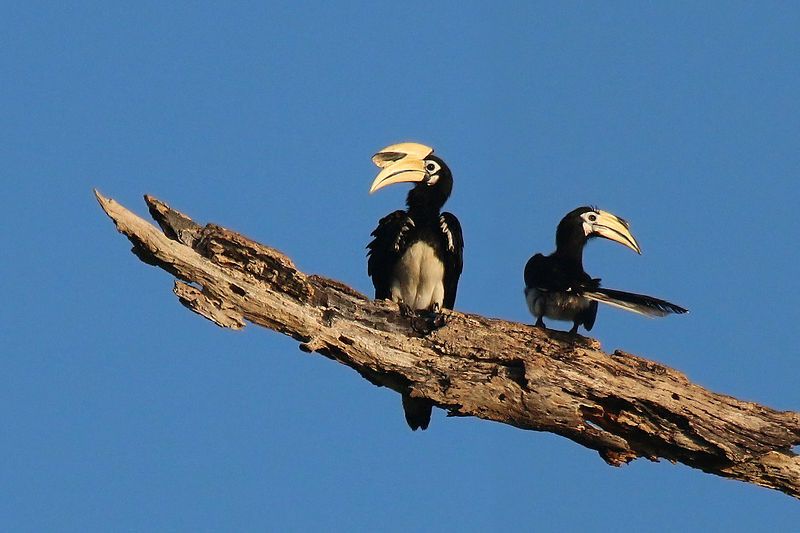
The oriental pied hornbill is a species of bird native to the Indo-Malayan region. It belongs to the Bucerotidae family, which includes other species of hornbills. It is also known by the names Sunda pied hornbill and Malaysian pied hornbill.
This species is significant because it is one of the smallest and most common of the Asian hornbills. The oriental pied hornbill is a large bird, usually found dwelling in canopy forests.
It has a distinctive black-and-white plumage, a large yellow bill, and a prominent casque, which is a bony growth on the upper side of its bill.
These birds are highly social and often travel in groups, foraging for food on the ground. The oriental pied hornbill is an omnivorous species, feeding on a variety of fruits, nuts, insects, and small animals.
It is also an important seed dispersal agent, as it carries and drops seeds while in flight. The oriental pied hornbill is listed as least concern by the International Union for Conservation of Nature.
Despite their wide range and large populations, they are threatened by deforestation and hunting. It is important that conservation efforts are taken to ensure that this species continues to thrive in the wild.
| Kingdom | Animalia |
| Phylum | Chordata |
| Class | Aves |
| Order | Bucerotiformes |
| Family | Bucerotidae |
| Genus | Anthracoceros |
| Species | A. albirostris |
2. Hornbill
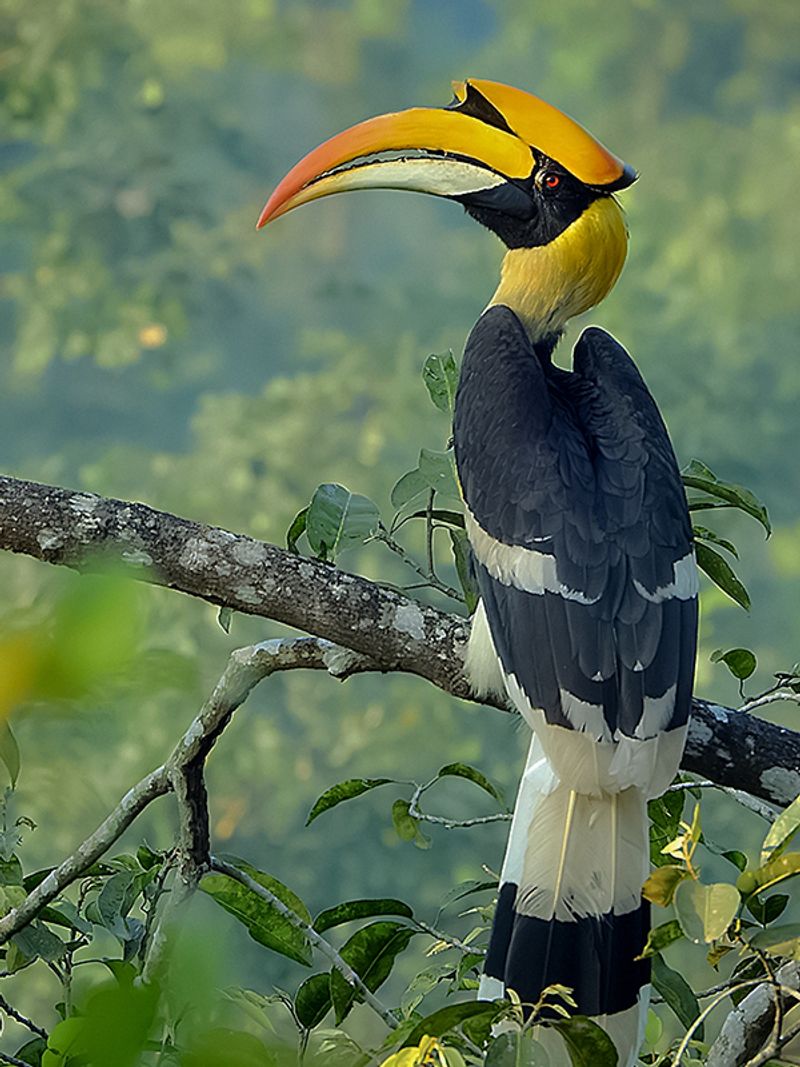
Hornbills are a group of birds that can be found in Africa, Asia, and Melanesia. They are easily recognizable due to their long, down-curved bills which often feature bright colours and a distinctive casque.
The casque is a bony structure that sits at the base of the upper mandible and is thought to be used in courtship displays.
Hornbills are found mainly in tropical and subtropical regions, and they inhabit a variety of habitats including forests, shrublands, grasslands, and mangroves. They feed mainly on fruits, insects, and small vertebrates such as lizards and snakes.
Some species also consume oil palm fruits, which makes them important dispersers of this crop. Hornbills have complex social behavior and form monogamous pairs that can remain together for many years.
They usually nest in cavities in tree trunks or cliffs, and the female will seal herself inside the nest with a mud wall before laying eggs. The male will then feed her through a small hole in the wall until the chicks are ready to fledge.
Hornbills are an important part of tropical ecosystems and play a role in seed dispersal and pollination.
| Kingdom | Animalia |
| Phylum | Chordata |
| Class | Aves |
| Order | Bucerotiformes |
| Family | Bucerotidae |
3. Collared Kingfisher
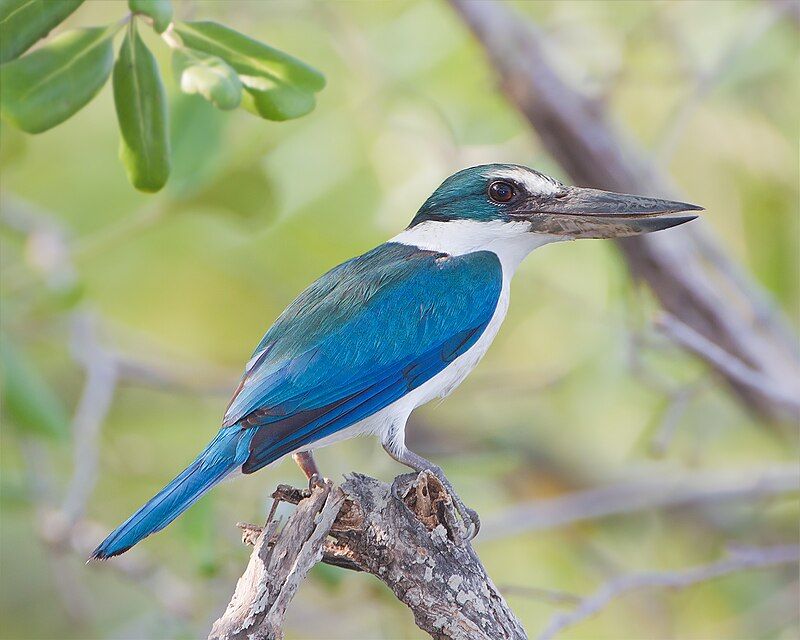
The collared kingfisher is a species of kingfisher that belongs to the subfamily Halcyoninae. This species is also known by a few other names, such as white-collared kingfisher, black-masked kingfisher, or mangrove kingfisher, due to its distinctive markings.
It is a medium-sized bird and is found in a wide range of locations, from the Red Sea across southern Asia to Polynesia. The collared kingfisher has a bright blue back and wings, a white breast, and a black mask. It has a long bill, which it uses to catch prey.
It feeds on both aquatic and terrestrial insects, as well as small fish and crustaceans.
It is also known to occasionally eat small birds and reptiles. The collared kingfisher has a wide habitat range, which includes mangrove swamps, rivers, lakes, dams, estuaries, and coastal wetlands. It is a sociable bird and is often seen in pairs or small groups.
It builds its nest in cavities in trees and lays up to five eggs in a single clutch. The collared kingfisher is an important species in its range, as it helps to keep insect populations in check.
It is also a popular bird for birdwatchers, as it is relatively easy to spot in its natural habitat.
| Kingdom | Animalia |
| Phylum | Chordata |
| Class | Aves |
| Order | Coraciiformes |
| Family | Alcedinidae |
| Genus | Todiramphus |
| Species | T. chloris |
4. Common Kingfisher
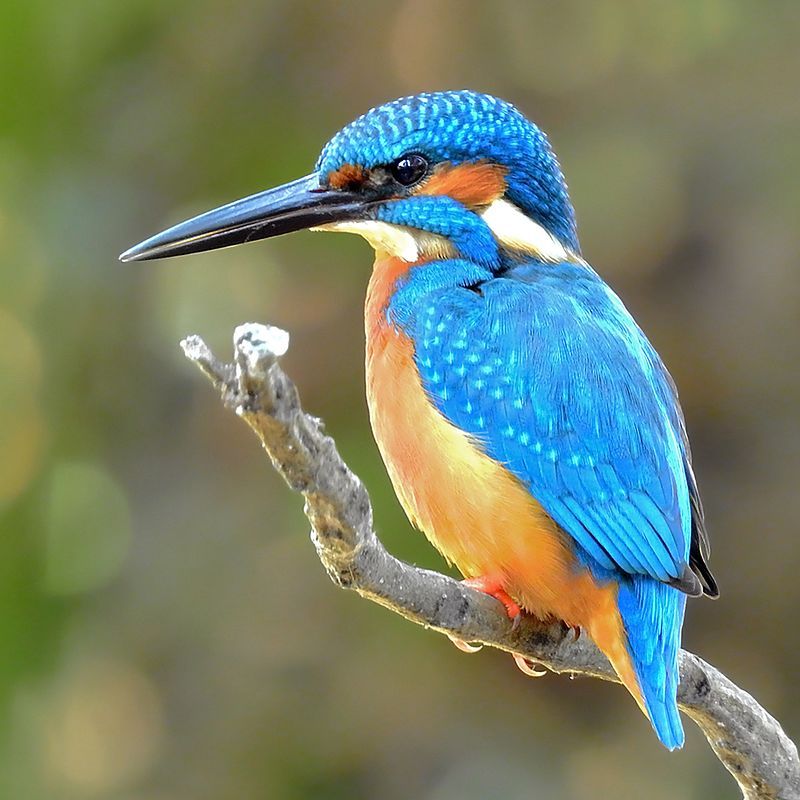
The common kingfisher, also known as the Eurasian kingfisher and river kingfisher, is a small bird that is found throughout Eurasia and North Africa. It is distinctive for its bright blue and orange plumage, and it is easily recognizable by its loud, shrill call.
There are seven subspecies of the common kingfisher, each of which can be found in its own unique range and habitat. The kingfisher is generally a resident species in much of its range, but it will migrate from areas where the rivers freeze during the winter months.
This is done in order to find more hospitable climates and more plentiful food sources. The kingfisher is an important species in many ecosystems, as it helps to reduce the number of insects and other small animals, such as fish, that it preys upon.
| Kingdom | Animalia |
| Phylum | Chordata |
| Class | Aves |
| Order | Coraciiformes |
| Family | Alcedinidae |
| Genus | Alcedo |
| Species | A. atthis |
5. Kingfisher
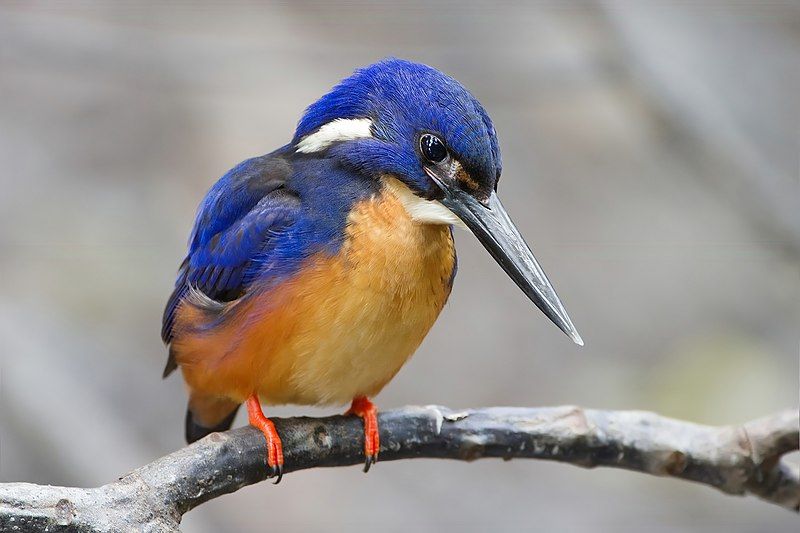
Kingfishers are a diverse family of birds belonging to the Coraciiformes order. They come in a range of sizes, from small to medium-sized, and they are known for their bright, vibrant colors.
They can be found in many parts of the world, particularly in tropical areas of Africa, Asia, and Oceania. However, they also have a presence in Europe, which makes them one of the few bird families with a truly cosmopolitan distribution.
These birds are often seen near rivers, lakes, and other bodies of water, where they feed on fish and other aquatic animals. They have large, sharp bills that they use to hunt, and they can often be seen perched on branches or hovering in the air to catch their prey.
Kingfishers are important predators in their habitats, helping to keep the ecosystem balanced.
| Kingdom | Animalia |
| Phylum | Chordata |
| Class | Aves |
| Order | Coraciiformes |
| Family | Alcedinidae |
6. Lesser Whistling Duck
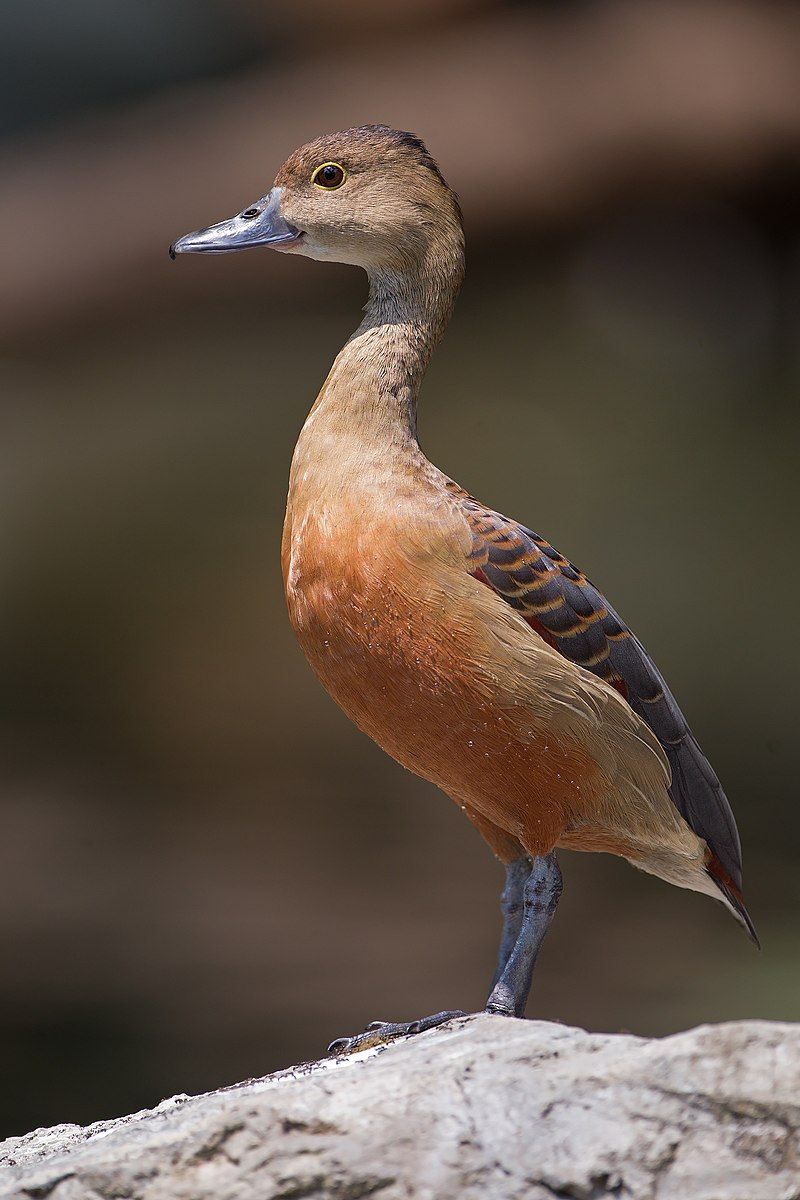
The lesser whistling duck is a species of waterfowl native to the Indian subcontinent and Southeast Asia. It is also known by other names such as Indian whistling duck and lesser whistling teal.
These ducks are nocturnal feeders, meaning they feed at night, and during the day they can be found in large groups around lakes and wet paddy fields.
The lesser whistling duck is a relatively small species of whistling duck, with an average length of around 45 cm and a wingspan of around 90 cm. Its plumage is a mix of browns and whites, with its head and neck a pale grey and its chest a dark brown.
Its bill is yellow and its legs are a bright orange-red color. The diet of the lesser whistling duck consists mainly of seeds, insects, and aquatic vegetation. They also feed on small fishes, mollusks, and crustaceans.
The species is monogamous, meaning the same pair of birds will breed together every year. The male will collect materials to build the nest and guard it while the female incubates the eggs.
The eggs are incubated for about 24-25 days and the chicks are able to fly within 40 days of hatching. The lesser whistling duck is an important species for the local communities where it lives, as it helps to maintain the balance of the wetland ecosystems.
It is also a popular game bird, hunted for its meat and eggs. Unfortunately, the species is threatened by habitat destruction and hunting and is listed as near-threatened on the IUCN Red List. Conservation efforts are being made to protect this species and its habitat.
| Kingdom | Animalia |
| Phylum | Chordata |
| Class | Aves |
| Order | Anseriformes |
| Family | Anatidae |
| Genus | Dendrocygna |
| Species | D. javanica |
7. Pink-necked Green Pigeon
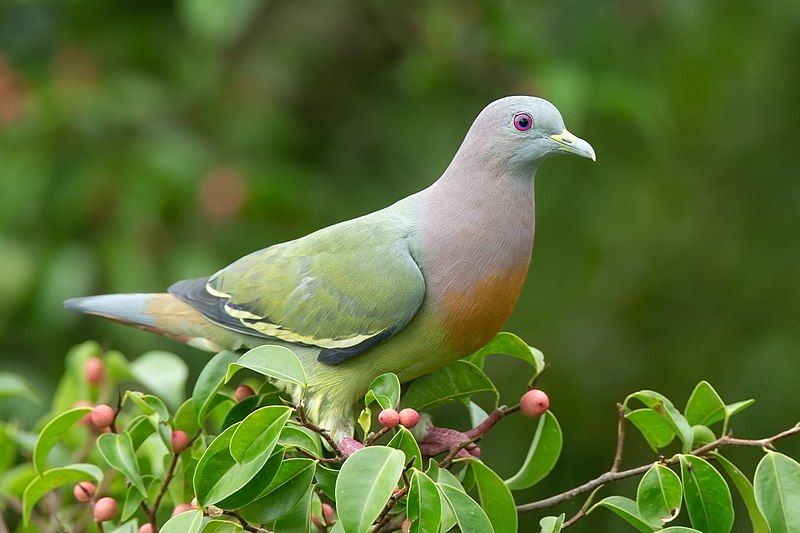
The pink-necked green pigeon is a species of bird that belongs to the Columbidae family, which includes both pigeons and doves.
This species is native to Southeast Asia, with its range extending from Myanmar and Vietnam southwards to the major islands of Indonesia and the Philippines. It is a fairly common species in these areas, often seen in forests, woodlands, and agricultural areas.
The pink-necked green pigeon is a medium-sized bird, ranging from 33 to 38 cm in length. It has a distinctive bright green plumage with a pink neck, and its wings are a darker green color.
Its diet consists mainly of fruits and seeds, and it is known to sometimes scavenge for food. The pink-necked green pigeon is an important species in its native range, as it helps to disperse the seeds of many plants and trees, thus playing a vital role in the local ecology.
| Kingdom | Animalia |
| Phylum | Chordata |
| Class | Aves |
| Order | Columbiformes |
| Family | Columbidae |
| Genus | Treron |
| Species | T. vernans |
8. Zebra Dove
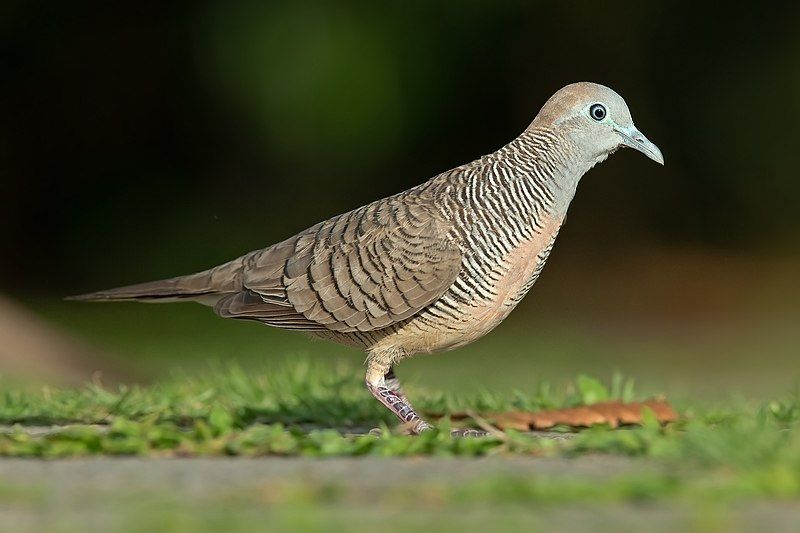
The zebra dove is a species of bird belonging to the Columbidae family, which is native to Southeast Asia. It is a small bird, measuring about 12-14cm in size, with a long tail and mottled grey-brown plumage.
The bird’s distinguishing feature is the black-and-white stripes that run along its body, giving it its name. These stripes extend from its head and chest, down its back, and all the way to its tail. Its wings are also barred with stripes, and it has a white patch on its throat.
The zebra dove is also known as the barred ground dove or barred dove, due to the distinct black-and-white markings on its feathers. The zebra dove is a social bird, often seen in flocks of up to 20 individuals.
It feeds on seeds and insects, and can often be seen foraging on the ground. It is known for its melodious call and can be heard at dawn and dusk. It is quite common in its native habitats, but its population is declining due to habitat loss.
The zebra dove is an important species in Southeast Asia, both culturally and ecologically. It is widely regarded as a symbol of good luck, and its feathers are used in traditional ceremonies.
It is also an important pollinator, helping to spread the seeds of many plants in its native ecosystems.
| Kingdom | Animalia |
| Phylum | Chordata |
| Class | Aves |
| Order | Columbiformes |
| Family | Columbidae |
| Genus | Geopelia |
| Species | G. striata |
9. Greater Racket-tailed Drongo
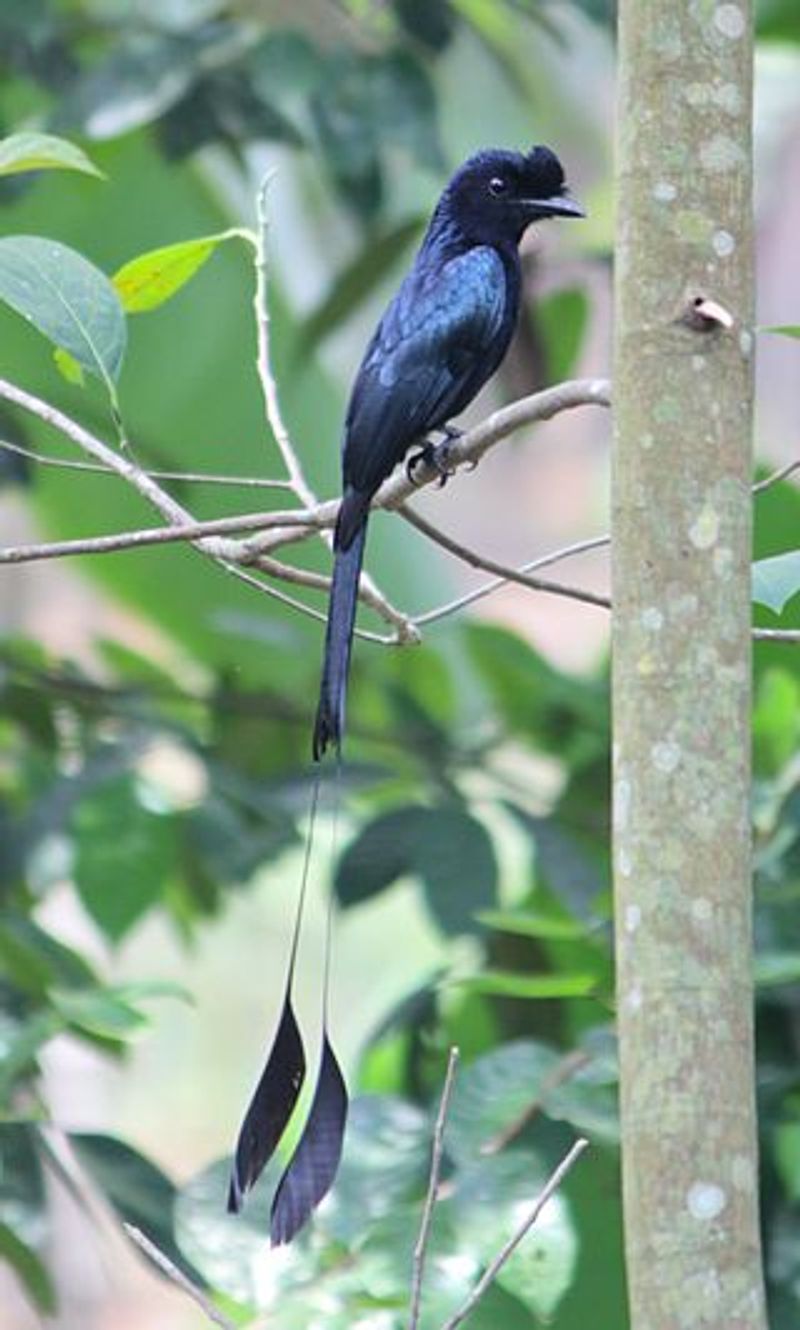
The greater racket-tailed drongo is a medium-sized bird native to Asia. It is easily recognizable by its elongated outer tail feathers which have webbing only at the tips. This type of drongo is part of the Dicruridae family, which includes other species of drongos.
The greater racket-tailed drongo has a glossy black plumage and a thick, curved beak. It is a fairly aggressive bird, often chasing away other species of birds from its territory. It is also known for its impressive aerial acrobatics while hunting insects in the sky.
The greater racket-tailed drongo is omnivorous, eating a variety of insects, fruit, and small animals. It builds its nest in trees or on cliffs to protect its young. The greater racket-tailed drongo is a common species and is widespread throughout its native range.
| Kingdom | Animalia |
| Phylum | Chordata |
| Class | Aves |
| Order | Passeriformes |
| Family | Dicruridae |
| Genus | Dicrurus |
| Species | D. paradiseus |
10. Emerald Dove
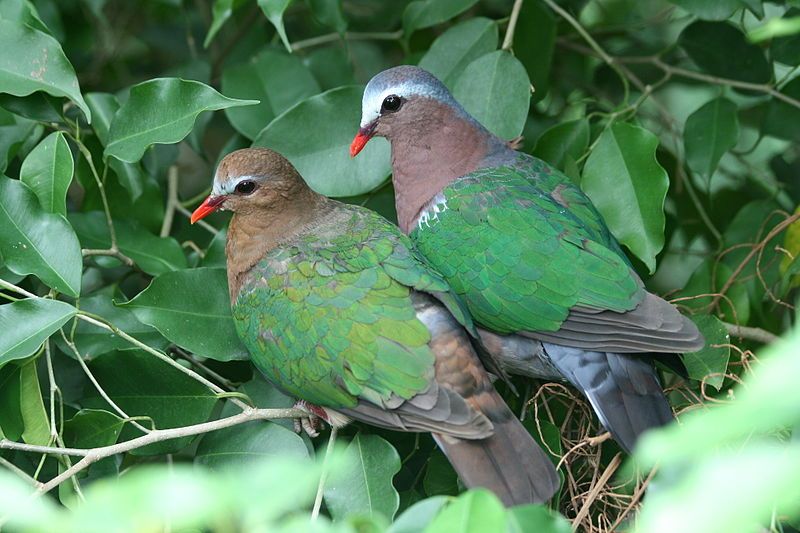
The emerald dove is a species of pigeon found in tropical and subtropical regions of the Indian Subcontinent and Southeast Asia.
It is known by many different names, including the common emerald dove, Asian emerald dove, grey-capped emerald dove, green dove, and green-winged pigeon. This colorfully-plumed bird measures around 30 centimeters in length and is a widespread resident breeding species.
Its main habitat is the dense forests found in tropical and subtropical regions, where it feeds on seeds, fruits, and small invertebrates. The emerald dove is also commonly found in agricultural lands, residential areas, and open woodland, where it nests in trees and shrubs.
This species has adapted to live in close proximity to humans, making it one of the most commonly seen doves in the region. The emerald dove is a monogamous species, with both parents taking part in raising their young.
They produce a low, cooing call, often heard in the early hours of the morning.
| Kingdom | Animalia |
| Phylum | Chordata |
| Class | Aves |
| Order | Columbiformes |
| Family | Columbidae |
| Genus | Chalcophaps |
| Species | C. indica |
11. Little Green Pigeon

Source: ebird.org
The little green pigeon is a species of bird that belongs to the family Columbidae. It is native to areas such as Brunei, Indonesia, Malaysia, Singapore, and Thailand.
This species is adapted to living in subtropical or tropical moist lowland forests, making this its natural habitat. The little green pigeon is quite small when compared to other species within the Treron genus.
It is a unique species that has adapted to its environment to ensure survival. These birds are an important part of the ecosystem and play an integral role in the balance of nature. They are important pollinators and dispersers of seeds, which helps to maintain healthy forests.
They also play an important role in controlling the populations of certain insects, which helps to keep the environment in balance. Despite their small size, the little green pigeon is an important species to its environment.
| Kingdom | Animalia |
| Phylum | Chordata |
| Class | Aves |
| Order | Columbiformes |
| Family | Columbidae |
| Genus | Treron |
| Species | T. olax |
12. Cuckoos
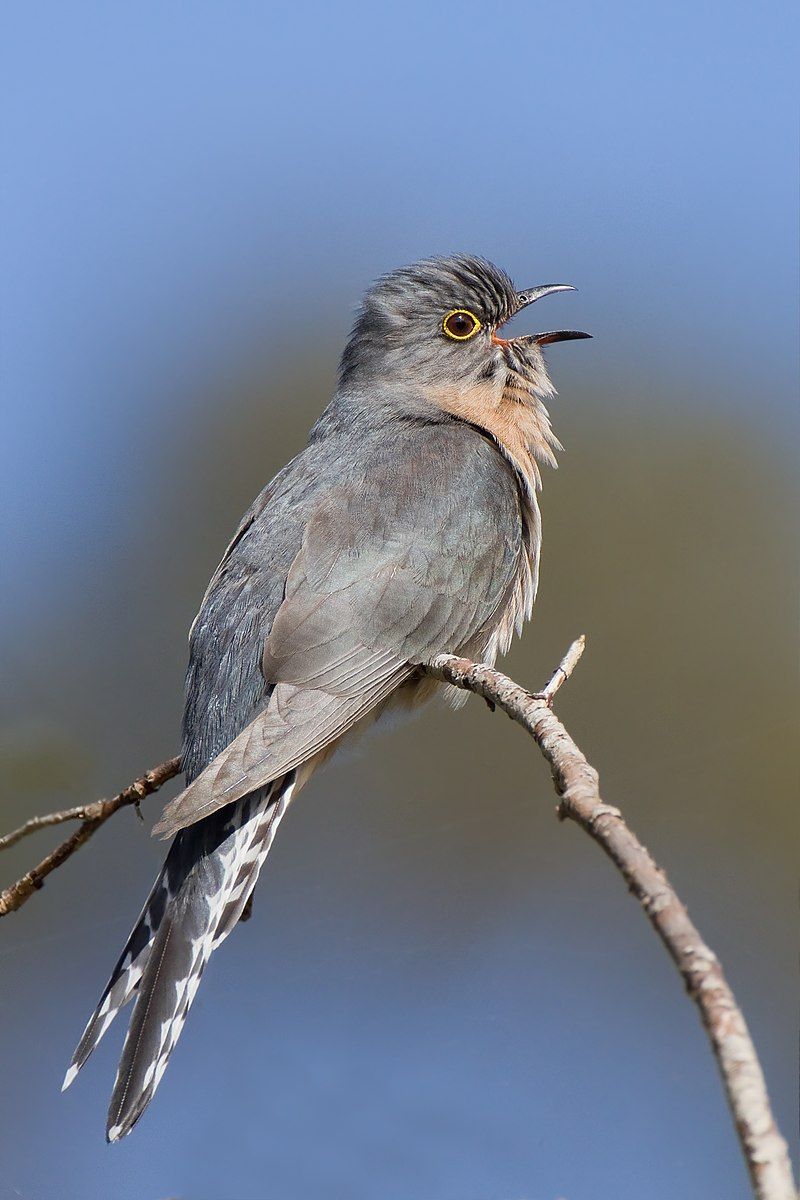
Cuckoos are birds belonging to the Cuculidae family, making them the only taxon in the order Cuculiformes. Cuckoos are quite diverse and include the common or European cuckoo, roadrunners, koels, malkohas, couas, coucals, and anis.
Although all of these birds are considered cuckoos, some ornithologists have suggested that coucals and anis should be classified as separate families, called the Centropodidae and Crotophagidae, respectively.
Each of these species has distinct physical and behavioral characteristics that set them apart from other cuckoo species, such as the coucal’s heavy body and its habit of walking on the ground.
No matter how they are classified, all cuckoos share certain traits, including a sharp call and the habit of laying their eggs in the nests of other birds.
| Kingdom | Animalia |
| Phylum | Chordata |
| Class | Aves |
| Clade | Otidimorphae |
| Order | Cuculiformes |
| Family | Cuculidae |
13. Black-winged Stilt
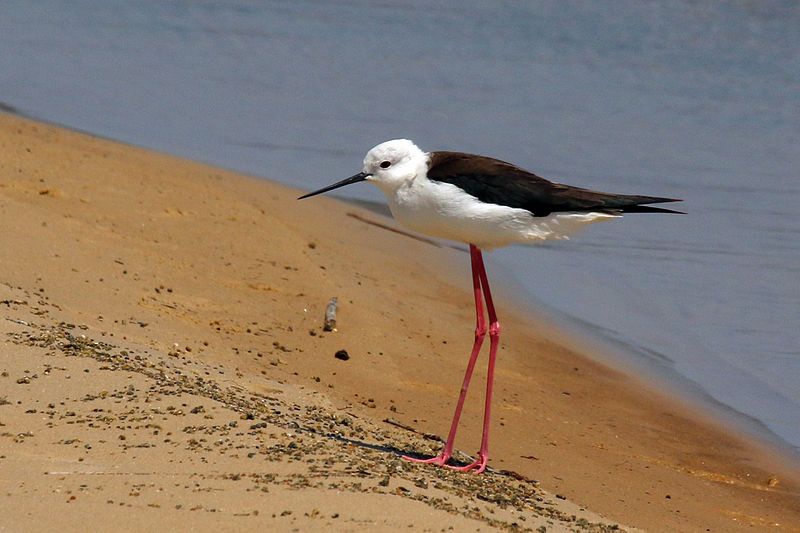
The black-winged stilt is a migratory bird that can be found in a variety of habitats across the world, from tropical wetlands to temperate ones. It is a member of the avocet and stilt family and is known for its very long legs.
Because of its wide distribution, the scientific name given to the species is H. himantopus, which means ‘long-legged’ in Latin. The black-winged stilt is a common sight in shallow wetlands, where it feeds on aquatic invertebrates such as insects, crustaceans, and mollusks.
It has a slender, black-and-white body with a long, slender black beak. Its legs are bright red, which is a distinguishing feature among wading birds. The black-winged stilt is usually seen in groups, and it is a graceful flier with a distinctive, undulating flight pattern.
The black-winged stilt is a single species that is almost cosmopolitan in its distribution, meaning that it is found in many parts of the world.
It is a very adaptable species, and it can be found in a variety of wetland habitats including marshes, shallow lakes, and tidal flats. As such, it is a valuable indicator species for wetland health and can help to identify areas of important habitat for other species.
| Kingdom | Animalia |
| Phylum | Chordata |
| Class | Aves |
| Order | Charadriiformes |
| Family | Recurvirostridae |
| Genus | Himantopus |
| Species | H. himantopus |
14. Malaysian Night Heron
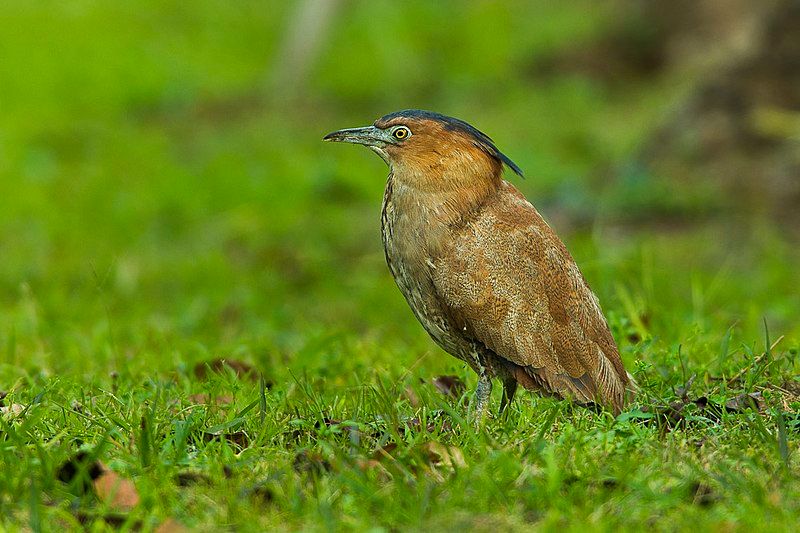
The Malayan night heron is a species of heron that is found in a variety of habitats in southern and eastern Asia. It is also known as the Malaysian night heron or tiger bittern.
This heron is a medium-sized bird, usually between 48-56 cm in length and weighing around 350-500 grams. It typically has dark brown or black plumage with white spots and stripes. The bill is thick and yellow, and the legs are long and grey.
The Malayan night heron feeds mainly on fish, frogs, and small invertebrates. It is a solitary bird, except during breeding season when it will congregate in colonies. Breeding takes place from April to June in most parts of its range.
The nest is usually a platform made of twigs and sticks, located in a tree or bush. The female will lay two to four eggs, which are incubated for around 25 days.
The Malayan night heron is listed as a species of least concern by the International Union for Conservation of Nature (IUCN). However, its population is declining due to habitat loss and degradation.
It is also hunted for food in some parts of its range, and its eggs are collected for consumption.
| Kingdom | Animalia |
| Phylum | Chordata |
| Class | Aves |
| Order | Pelecaniformes |
| Family | Ardeidae |
| Genus | Gorsachius |
| Species | G. melanolophus |
15. Herons
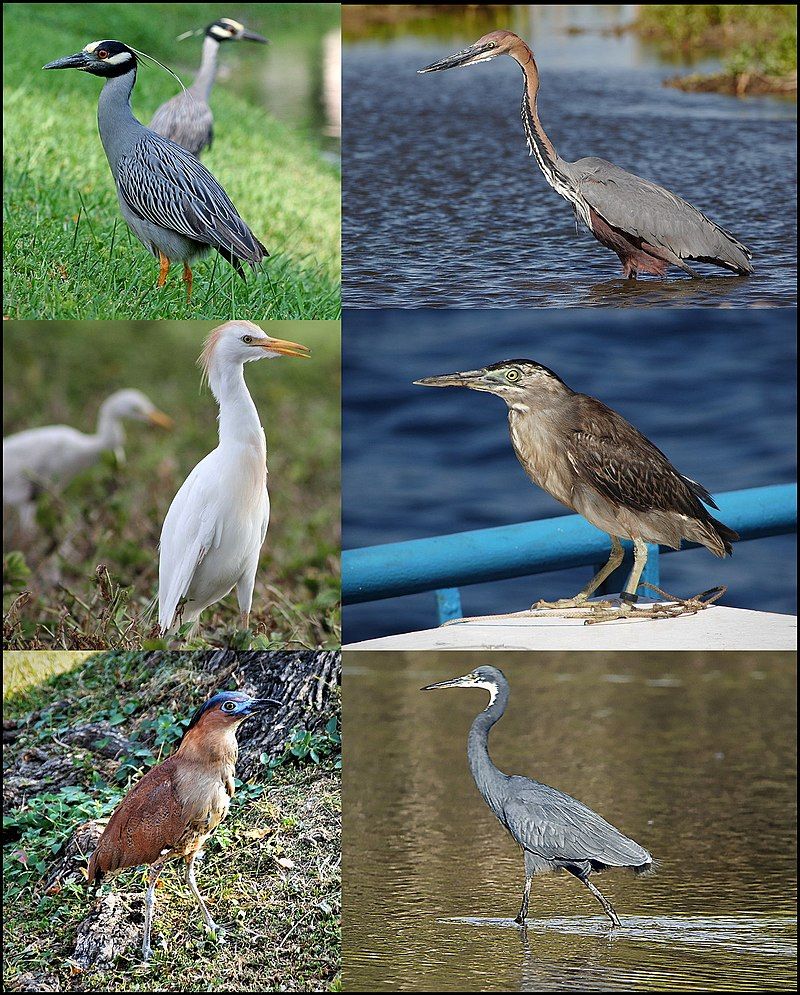
Herons are a large family of birds consisting of 72 species. They are typically found in both freshwater and coastal habitats. They are easily recognizable due to their long legs and necks. Herons are also known as Egrets or Bitterns, depending on the species.
These birds have a variety of sizes, ranging from the small Least Bittern to the large Great Blue Heron. Their diet consists mainly of fish, frogs, and insects. They can often be seen wading in shallow waters, where they use their long necks and beaks to search for prey.
Herons are also known to take on larger prey, such as snakes and small mammals. They generally use their beaks to tear their prey into smaller, more manageable pieces.
Herons can be found in a variety of habitats, from wetlands, marshes, estuaries, and riverbanks, to open fields, swamps, and woodlands. These birds are important to their ecosystems and play a vital role in controlling populations of insects, fish, and other small creatures.
| Kingdom | Animalia |
| Phylum | Chordata |
| Class | Aves |
| Order | Pelecaniformes |
| Family | Ardeidae |
16. Pacific Swift
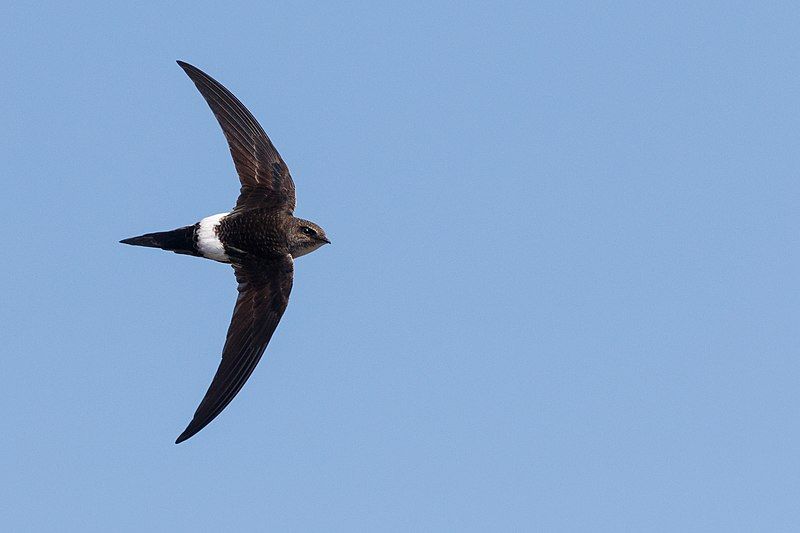
The Pacific swift, also known as the fork-tailed swift, is a species of bird from the Swift family. It is native to eastern Asia, where it breeds during the northern hemisphere’s summer months.
When winter comes around, the Pacific swift takes to the skies and migrates south towards Southeast Asia and Australia. This species is well-known for its incredible ability to fly, with some individuals having been recorded traveling over 7,000 miles in just a few weeks.
This impressive migratory feat is made possible by the swift’s streamlined body, large wingspan, and ability to take advantage of air currents.
In addition, the Pacific Swift is an incredibly agile flyer, able to quickly change direction and adjust its altitude to take advantage of even the slightest wind gusts. The Pacific swift is an important species to many local ecologies, as it feeds on a wide variety of insects.
Furthermore, its migration to warmer climates helps to spread the species’ genes and maintain genetic diversity. Unfortunately, the Pacific swift population is currently in decline due to habitat destruction, pollution, and overhunting.
Thankfully, conservation efforts are underway to help protect this species and ensure its continued survival.
| Kingdom | Animalia |
| Phylum | Chordata |
| Class | Aves |
| Clade | Strisores |
| Order | Apodiformes |
| Family | Apodidae |
| Genus | Apus |
| Species | A. pacificus |
17. Large-tailed Nightjar
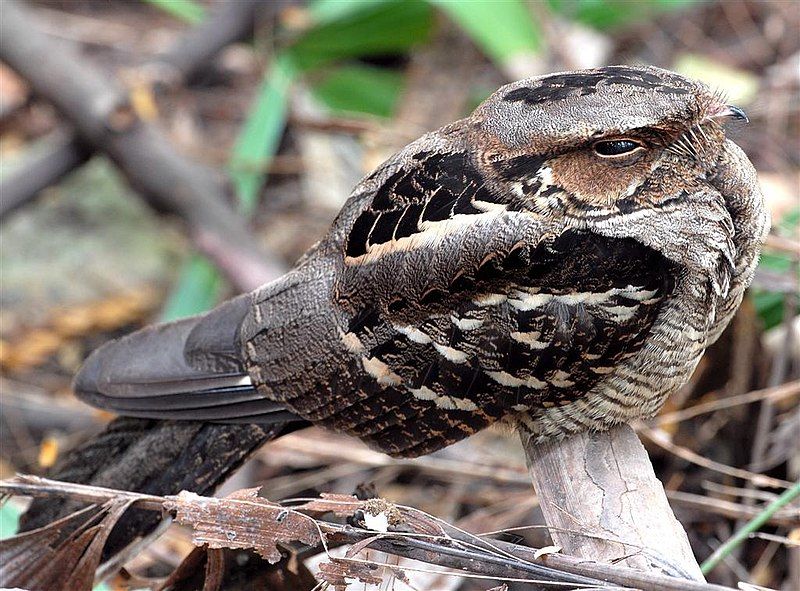
The large-tailed nightjar is a species of bird found in a range of areas, from the southern Himalayan foothills to eastern South Asia, Southeast Asia, and even northern Australia.
It belongs to the family Caprimulgidae, which also includes other species of nightjar such as the common nighthawk. This species of nightjar is a medium-sized bird, with a wingspan of around 36cm.
Its plumage is mostly greyish-brown, with long wings and a long tail and white patches on the wings and tail. It is mainly nocturnal, so it is active during the night and sleeps during the day. Its diet consists of small insects and other invertebrates such as moths and beetles.
The large-tailed nightjar is an important species in its habitats, as it helps to control the insect populations. It is also a species of conservation concern, as it is threatened by habitat loss and degradation due to urbanization, agricultural expansion, and illegal logging.
With appropriate conservation measures, the large-tailed nightjar can continue to be a part of our planet’s diverse bird life.
| Kingdom | Animalia |
| Phylum | Chordata |
| Class | Aves |
| Clade | Strisores |
| Order | Caprimulgiformes |
| Family | Caprimulgidae |
| Genus | Caprimulgus |
| Species | C. macrurus |
18. Malaysian Eared Nightjar

Source: ebird.org
The Malaysian-eared nightjar is a species of nightjar belonging to the family Caprimulgidae. It is found in the countries of Brunei, Indonesia, Malaysia, Singapore, and Thailand.
This species of bird is commonly found in subtropical or tropical moist lowland forests, where they prefer to inhabit. They typically have an olive-brown head and upperparts, a white to pale grey throat, and a white belly.
The underside of the wings and tail is barred. The Malaysian-eared nightjar is a nocturnal bird that mainly hunts at night, using its well-developed eyes to spot prey.
It mainly feeds on insects, such as moths, beetles, and ants, as well as small vertebrates like frogs, lizards, and small mammals. The Malaysian-eared nightjar is also known to feed on fruits such as figs and berries.
During the day, the Malaysian-eared nightjar perches on the ground, in trees, or on branches. The Malaysian eared nightjar is a solitary bird and is not known to form flocks. Breeding season for this species typically occurs between April and October.
The female typically lays two eggs in a cup-shaped nest on the ground or in a tree. The eggs are incubated by both the male and female.
The chicks are born after an incubation period of around two weeks.The Malaysian eared nightjar is considered to be a species of least concern by the International Union for Conservation of Nature (IUCN).
Despite this, it is still threatened by habitat loss due to deforestation and is also vulnerable to predation by larger birds of prey. As a result, conservation efforts are needed to ensure the species’ survival.
| Kingdom | Animalia |
| Phylum | Chordata |
| Class | Aves |
| Clade | Strisores |
| Order | Caprimulgiformes |
| Family | Caprimulgidae |
| Genus | Lyncornis |
| Species | L. temminckii |
19. Mountain Imperial Pigeon
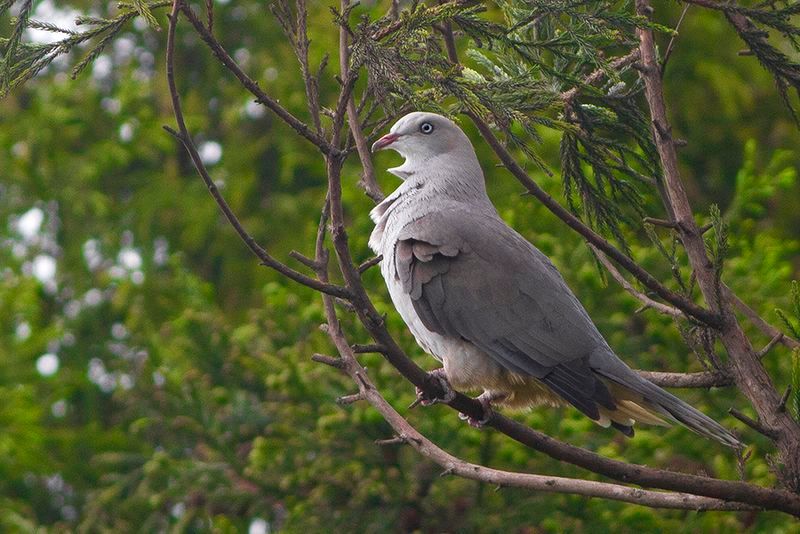
The mountain imperial pigeon is a species of bird that belongs to the pigeon and dove family and is widely distributed in Southeast Asia. It has two other common names, namely the maroon-backed imperial pigeon and Hodgson’s imperial pigeon.
This species is known for its large size and colorful plumage. The upperparts are a glossy maroon, while the underparts are a pale grey. The breast and throat are bright pinkish-red. The head of the mountain imperial pigeon is grey-blue, while the tail is long and pointed.
Its bill is grey and the legs are red. The mountain imperial pigeon feeds mainly on fruits, and can often be seen in large flocks. It is known to be a strong flier and is usually seen soaring high in the sky.
It has a loud, distinctive call that can be heard from a great distance.
The species is also known to be quite vocal during courtship, with males producing a loud cooing sound. The mountain imperial pigeon is a popular species for aviculture and can be found in many aviaries around the world.
It is an important part of the ecology of southeastern Asia, providing food and nesting opportunities for a variety of species. The species is listed as near-threatened due to habitat loss and illegal hunting.
| Kingdom | Animalia |
| Phylum | Chordata |
| Class | Aves |
| Order | Columbiformes |
| Family | Columbidae |
| Genus | Ducula |
| Species | D. badia |
20. Columbidae
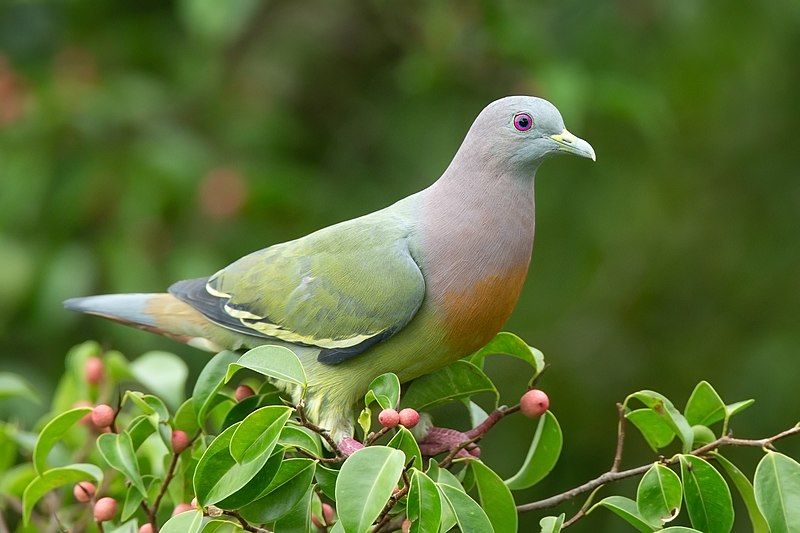
Columbidae is a family of birds that includes doves and pigeons. This family is the only one in the order Columbiformes, which encompasses all the birds with similar characteristics. These birds have a stout bodies with a short necks and a short, slender bills.
In some species, the bill has a fleshy cere on top. Columbids primarily feed on a diet of seeds, fruits, and plants. They are found in a variety of habitats, from forests and grasslands to urban areas.
Columbids are also known for their distinctive call, which is often a series of coos. They are an important species as they provide an important food source for many other animals, including humans.
| Kingdom | Animalia |
| Phylum | Chordata |
| Class | Aves |
| Clade | Columbimorphae |
| Order | Columbiformes |
| Family | Columbidae |
21. Cotton Pygmy Goose
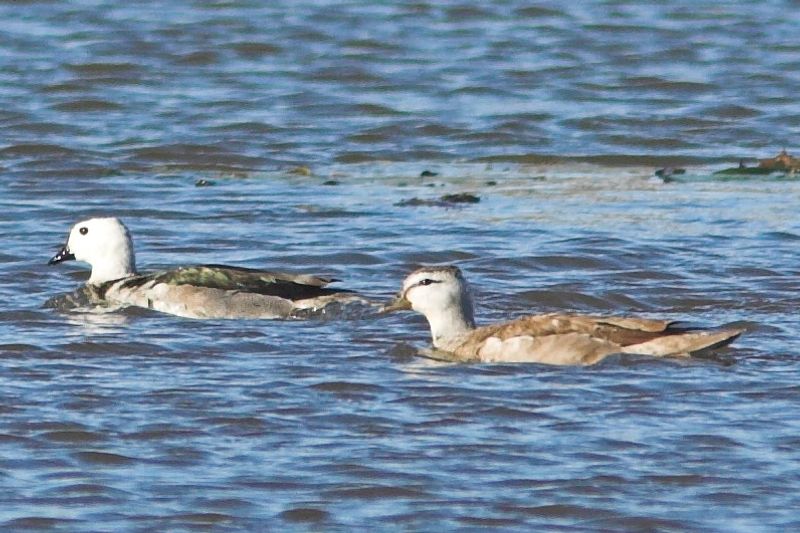
The Cotton Pygmy Goose, also known as the Cotton Teal, is a species of small perching duck that is native to parts of Asia, Southeast Asia, and even as far east as Queensland.
It is a small bird with white quills, which is why they are sometimes referred to as the White-Quilled Pygmy Goose. This species of duck is known to breed in these areas, making them a common sight in some areas.
They are also known to be quite small in size, with an average length of only around 20 cm. They have a unique coloration, typically having a grey and white pattern with a black bill and white quills.
This species of duck is known to feed mainly on aquatic vegetation, such as small insects, crustaceans, and plants. They are also known to be quite social creatures, often gathering in large groups in order to feed and socialize.
The Cotton Pygmy Goose is an important species of duck, and their populations are monitored closely in order to ensure their continued survival.
| Kingdom | Animalia |
| Phylum | Chordata |
| Class | Aves |
| Order | Anseriformes |
| Family | Anatidae |
| Genus | Nettapus |
| Species | N. coromandelianus |
22. Woodpeckers
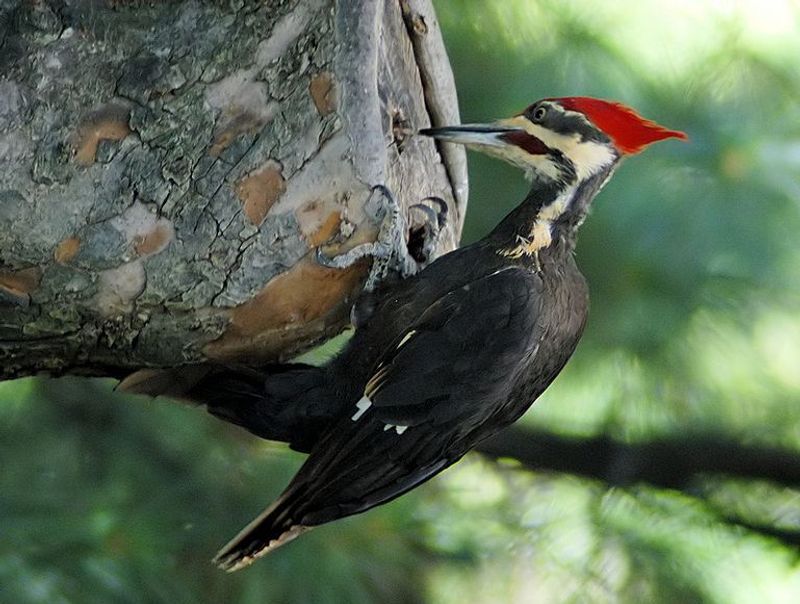
The bird family Picidae is a very diverse group, made up of woodpeckers, piculets, wrynecks, and sapsuckers. These birds are found on all continents, with the exception of Australia, New Guinea, New Zealand, Madagascar, and the extreme polar regions.
Picidae birds are most easily identified by their strong, sharp beaks used for drilling into tree bark to find food. They also have stiffened tails that serve as a support for them to lean against tree trunks while drilling.
While woodpeckers are the most commonly known members of the Picidae family, they are not the only ones. Piculets are small, colorful birds, often found in tropic and subtropical regions.
Wrynecks are small woodpeckers that are found in Europe, Asia, and Africa, while sapsuckers are larger woodpeckers found in North and South America.
All of these birds have specialized diets, such as insects, sap, and fruit, which make them important members of their ecosystems.
| Kingdom | Animalia |
| Phylum | Chordata |
| Class | Aves |
| Order | Piciformes |
| Family | Picidae |
23. Little Egret
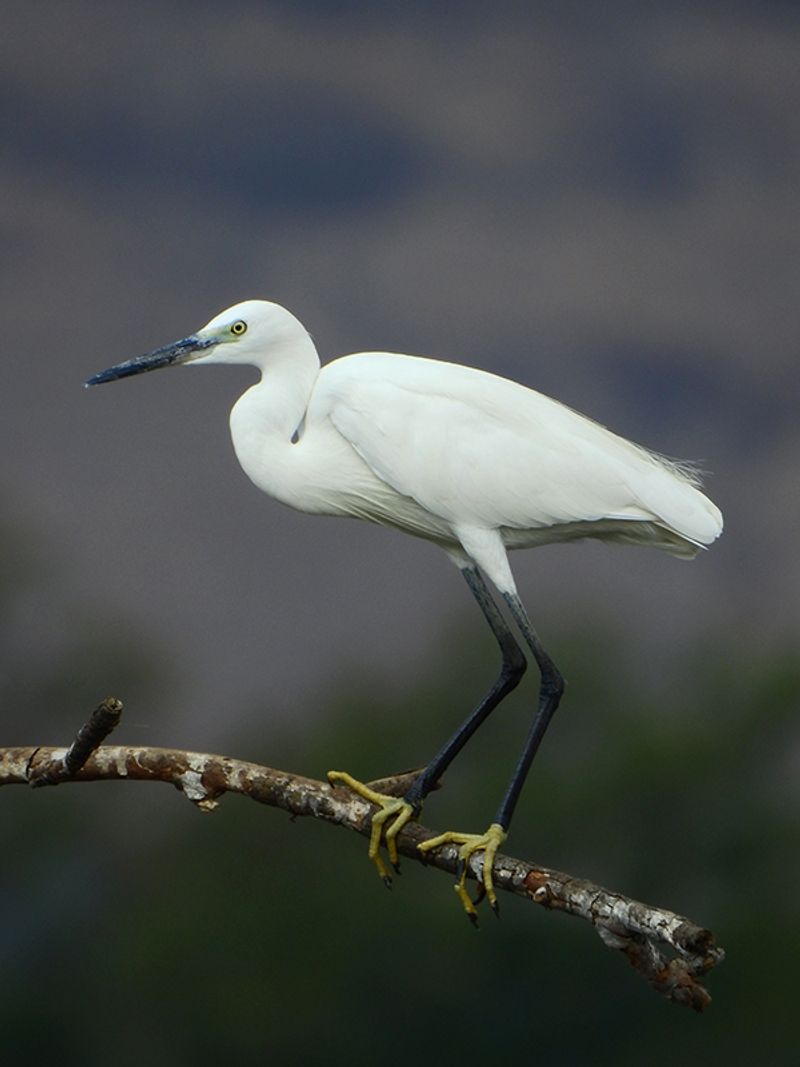
The little egret is a species of small heron that is found in the family Ardeidae. It is a white bird with a slender black beak and long black legs. The western race of this species of bird has a unique feature — yellow feet.
This bird is an aquatic creature which means that it feeds both in shallow water and on land. It consumes a variety of small creatures such as insects, crustaceans, amphibians, reptiles, and fish.
The little egret is an important species for the maintenance of the balance of the aquatic ecosystem because of its role in controlling the populations of its prey.
With its long legs, it is able to wade in shallow water, and with its long beak, it is able to capture prey with precision. Its yellow feet allow it to move quickly on land, and its white color helps it blend in with its surroundings.
The little egret is an important species for its contribution to the environment and its unique features.
| Kingdom | Animalia |
| Phylum | Chordata |
| Class | Aves |
| Order | Pelecaniformes |
| Family | Ardeidae |
| Genus | Egretta |
| Species | E. garzetta |
Conclusion
Johor is home to a variety of bird species that are both endemic and migratory. This diversity of avian life makes Johor a great place to explore and observe birds.
The many wetlands and forests of the region provide a wealth of habitat for birds, and the protected areas of the state ensure that the bird populations remain healthy.
With its unique combination of habitats and species, Johor is an ideal place to observe and appreciate the beauty of birds.